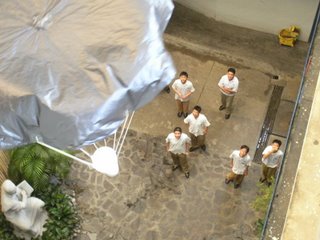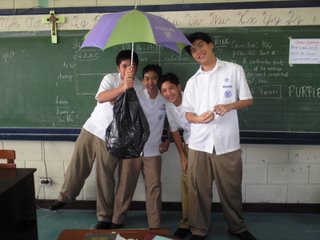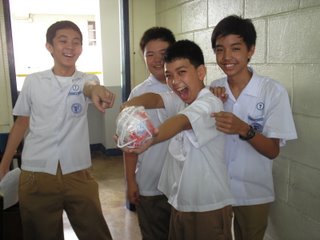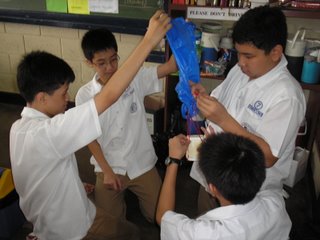the eggsperiment





Last year was dissection; this year, its Egg Drop!
This is a direct quote form one of my Grade 7 students after completing the Egg Drop Experiment. The students were so hyped up after launching and retrieving their egg setup that they forgot that they needed to check if their egg survived the fall. But I’m getting ahead of my story….
The Egg Drop I was referring to was the Egg Drop experiment which we performed at the start of the second quarter. This “eggsperiment” is a bridge between the past and the future; the bridge between the students’ lessons in grade six with the lessons in grade seven. After having almost 4 years of experiment experience to back the students, we decided it was time for the students to do an experiment from scratch. And so, for this experiment, the students were given the following challenge: help a raw egg survive a fall from a 4 storey drop with 5 different kinds of materials. To accomplish this, students must plan for the experiment and create their own lab format, including the requisite parts; problem, hypothesis, materials, procedure, observation and finally, conclusion.
This challenge also involved recalling the different kinds of forces. After identifying the forces that will be a factor in this experiment, the students enthusiastically went into the planning for the experiment. Listening to the plans of the students gives one an idea of how ingenious our boys are…or how some show traits of being methodical and thorough. Years of experience taught them that each member of the group had something to contribute to the process so it was hardly a surprise to see various diagrams to show the free flow of different ideas. This phase of the experiment ended with the submission of their partially finished lab format and the prospect of doing the actual experiment the following meeting.
True to form, each class who will be launching their egg setups came to school prepared…some even beyond prepared. They were given half of the period to put together the setup from scratch. Working feverishly and intently, most of the groups were able to faithfully create what they envisioned would be a good vessel for the egg. Armed with different tools (needles, glue gun, scissors) and materials (umbrellas, egg cartons, pillows, cotton, tissue, Styrofoam boxes, and pencil cases) each group prepared their setup for the launch. A gofer was sent to the pocket garden directly above the Grade Seven faculty workroom to retrieve the launched setup. As each setup was released, students could not help but cheer for everyone’s setup, much to the consternation of some onlookers. But how can one not cheer? You see a parachute fashioned from a garbage bag unfurl fully to catch the air as it goes down, or a lunch bag stuffed with crumpled paper come crashing down to the ground with a thud or a carton propeller gently floating as it goes down with grace….and so on and so forth….
In the end, students realized it was not so much of the appearance of the setup, or the variety of materials brought to school. It was old-fashioned implementation of the lessons learned: how to defy gravity, how to increase drag, or how to lessen the impact from the fall. There were other “un-science” lessons too…lessons on cooperation, listening to other group mates, patience and realizing that there will always be problems (in this case, gravity) and so, sometimes, its just a matter of how to go around it, or at least lessen its impact on us.
All in all, I would say it was a successful experiment. A testament for this would be the students’ insights written in their own lab formats but more importantly, the good feelings that each one had after the experiment, whether it was successful or not. Students enjoyed this science lesson; and they learned something from it too. As a teacher I couldn’t ask for any other “eggciting” result.

0 Comments:
Post a Comment
<< Home